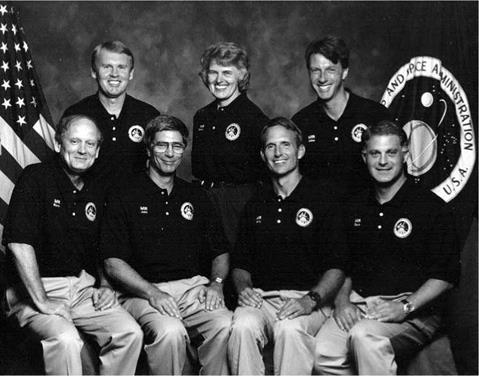FOR ALL MANKIND
Between 1961 and 1977, all manned space flight orbital programmes had been completed by either American (NASA) astronauts (Mercury-Gemini-Apollo- Skylab-ASTP) or Russian cosmonauts (Vostok-Voskhod-Soyuz-Salyut). American plans to fly the Space Shuttle, with reduced stress on launch and landing and with nonpilot crew positions, offered the chance to fly non-professional crew members – scientists or engineers who could operate specialist equipment on the orbital stages of the flight, either in a dedicated research laboratory (Spacelab), on the mid-deck, or on pallets in the payload bay from the aft flight deck. These opportunities were offered to foreign space agencies as well, including those of Australia, Canada, Europe and Japan.
|
|
Mir in 1998 showing the four add-on modules, a docked Progress and Kvant at rear, and a Soyuz TM spacecraft in centre. Clockwise from left: Kvant-2 showing unused MMU outside on support frame; Priroda; Spektr (showing damaged arrays); and Kristall with attached Shuttle Docking Module
|
Table 3.3. Mir and its modules
The four latter modules were initially docked to the front port before being relocated to the required side docking port using a small robot arm. |
|
The seven NASA astronauts who lived and worked on Mir between 1995 and 1998: l to r – Thagard, Thomas, Blaha, Lucid, Linenger, Foale, Wolf |
The Soviet Union, wishing to steal some of the thunder from flying the first mission and payload specialists on the Shuttle, initiated a programme in 1976 to fly “guest cosmonauts” under the Interkosmos programme, starting in 1978. Interkosmos was a cooperative space science programme of the Eastern bloc countries, which was expanded to include flights of minimally-trained “cosmonauts” from these member countries alongside flight-experienced Soviet cosmonauts on short “visiting missions” to space stations. These “international” missions were gradually expanded to include other space-partner nations (France, India) and later with a more commercial eye following the break-up of the Soviet Union. The US Shuttle flight opportunities also expanded to include representative crew members from countries who booked a majority payload, representatives from US governmental departments, or military officers supporting DoD payloads. There were also plans to fly a teacher and a journalist on the Shuttle, in what was hoped to be the beginning of more “routine” access to space for anyone suitably qualified and trained from across the planet.
With the International Space Station, such opportunities have again been promoted “for the benefit of all mankind”, although the programme still remains to realise its status as a truly international space complex.
|
Table 3.4. Shuttle orbiters summary 1977-2006
|












